Perch Market
Perch Market Size and Share Forecast Outlook 2025 to 2035
Perch market is projected to grow from USD 3.5 billion in 2025 to USD 4.6 billion by 2035, at a CAGR of 2.8%. European Perch will dominate with a 52.0% market share, while fresh will lead the form segment with a 48.0% share.
Perch Market Forecast and Outlook 2025 to 2035
The global perch market is valued at USD 3.5 billion in 2025. It is slated to reach USD 4.6 billion by 2035, recording an absolute increase of USD 1.1 billion over the forecast period. This translates into a total growth of 31.4%, with the market forecast to expand at a CAGR of 2.8% between 2025 and 2035.
The market size is expected to grow by nearly 1.3X during the same period, supported by increasing demand for eco-friendly seafood, growing adoption of freshwater aquaculture, and rising emphasis on protein-rich food sources across diverse retail markets, food service establishments, and export channels.
Quick Stats for Perch Market
- Perch Market Value (2025): USD 3.5 billion
- Perch Market Forecast Value (2035): USD 4.6 billion
- Perch Market Forecast CAGR: 2.8%
- Leading Species in Perch Market: European Perch
- Key Growth Regions in Perch Market: North America, Europe, and Asia Pacific
- Key Players in Perch Market: Regional Aquaculture Companies, Clearwater Seafoods, Marine Harvest, Cermaq, Tassal, Trident Seafoods
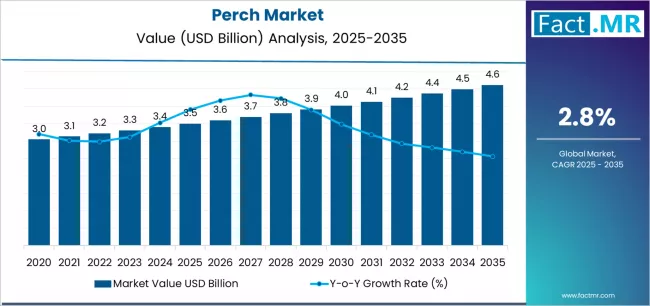
Between 2025 and 2030, the perch market is projected to expand from USD 3.5 billion to USD 4.0 billion, resulting in a value increase of USD 0.5 billion, which represents 45.5% of the total forecast growth for the decade. This phase of development will be shaped by increasing eco-friendly fishing practices, rising aquaculture production capacity, and growing demand for freshwater fish protein in food service and retail applications.
From 2030 to 2035, the market is forecast to grow from USD 4.0 billion to USD 4.6 billion, adding another USD 0.6 billion, which constitutes 54.5% of the ten-year expansion. This period is expected to be characterized by the expansion of value-added processing and premium product development, the development of eco-friendly aquaculture systems and traceability technologies, and the growth of specialized applications in gourmet cuisine and health-conscious consumer segments.
Perch Market Key Takeaways
| Metric | Value |
|---|---|
| Estimated Value in (2025E) | USD 3.5 billion |
| Forecast Value in (2035F) | USD 4.6 billion |
| Forecast CAGR (2025 to 2035) | 2.8% |
The global seafood market is the largest contributor, accounting for approximately 35-40%. Perch, being a popular freshwater fish, is widely consumed in various regions, particularly in North America and Europe, for its mild flavor and versatile use in culinary applications. As consumer demand for fish and seafood continues to rise due to health benefits such as high protein content and omega-3 fatty acids, perch remains a staple in the diet of many populations. The aquaculture and fisheries market holds around 25-30%, as the farming and eco-friendly harvesting of perch has become an important aspect of the seafood industry, particularly in regions with freshwater availability and growing interest in fish farming for commercial purposes.
The recreational fishing market contributes approximately 15-18%, as perch is a popular species among anglers, contributing to the demand for both wild-caught and stocked perch in freshwater lakes and rivers. The restaurant and hospitality market accounts for about 12-15%, as perch is frequently featured in menus at seafood restaurants, offering consumers a fresh, affordable alternative to other fish varieties. The environmental and conservation market represents about 8-10%, as the eco-compatibility of perch populations and their ecosystems is increasingly being emphasized in both wild fisheries and aquaculture settings.
Why is the Perch Market Growing?
Market expansion is being supported by the increasing global focus on eco-friendly seafood consumption and responsible fishing practices driven by environmental consciousness and food security concerns, alongside the corresponding demand for freshwater fish products that can enhance protein supply, enable eco-friendly aquaculture development, and maintain ecosystem balance across various retail markets, food service establishments, processing facilities, and export channels. Modern seafood producers and aquaculture operators are increasingly focused on implementing perch production solutions that can improve supply eco-compatibility, enhance product quality, and provide consistent availability in demanding market conditions.
The growing emphasis on healthy protein alternatives and freshwater aquaculture is driving demand for perch products that can support nutritional requirements, enable eco-friendly production methods, and ensure comprehensive food safety effectiveness. Seafood industry producers' preference for versatile fish species that combine nutritional benefits with environmental eco-compatibility and market acceptance is creating opportunities for innovative aquaculture implementations. The rising influence of eco-friendly consumption trends and protein diversification is also contributing to increased adoption of perch products that can provide superior nutritional outcomes without compromising environmental eco-compatibility or food safety.
Segmental Analysis
The market is segmented by species, form, and distribution. By species, the market is divided into European perch, yellow perch, and others. Based on form, the market is categorized into fresh, frozen, and processed/fillets. By distribution, the market is split between retail, foodservice, and export.
By Species, the European Perch Segment Leads the Market
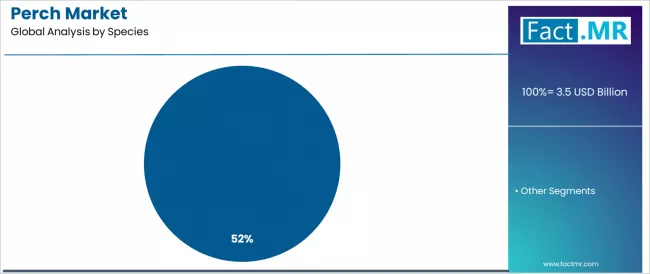
The European perch species segment is projected to maintain its leading position in the perch market in 2025 with a 52% market share, reaffirming its role as the preferred species for commercial aquaculture and comprehensive seafood production. Aquaculture producers and seafood suppliers increasingly utilize European perch for their superior growth characteristics, excellent meat quality, and proven performance in delivering consistent yields while maintaining taste profiles and market acceptance. European perch technology's proven effectiveness and aquaculture versatility directly address production requirements for eco-friendly farming and reliable market supply across diverse aquaculture operations and seafood protocols.
This species segment forms the foundation of modern perch aquaculture, as it represents the species with the greatest contribution to commercial production and established market record across multiple aquaculture applications and farming protocols. Seafood industry investments in eco-friendly aquaculture technologies continue to strengthen adoption among producers and suppliers. With increasing demand for eco-friendly freshwater fish and proven aquaculture performance, European perch aligns with both production objectives and eco-compatibility requirements, making it the central component of comprehensive perch production strategies.
By Form, the Fresh Segment Dominates Market Demand
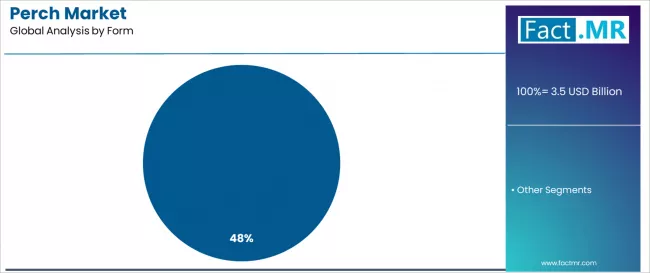
The fresh form segment is projected to represent the largest share of perch demand in 2025 with a 48% market share, underscoring its critical role as the primary form for perch consumption across retail markets, restaurants, and direct sales channels. Consumers and food service operators prefer fresh perch for culinary applications due to their exceptional taste characteristics, comprehensive culinary versatility, and ability to support complex recipe requirements while maintaining flavor integrity and nutritional value objectives. Positioned as premium products for modern seafood consumption, fresh perch offers both culinary advantages and nutritional benefits.
The segment is supported by continuous innovation in cold chain technology and the growing availability of fresh distribution systems that enable superior product quality with enhanced freshness preservation and improved supply chain coordination. Seafood retailers are investing in comprehensive fresh seafood programs to support increasingly demanding consumer standards and product requirements for high-quality and fresh fish products. As consumer preferences advance and freshness requirements increase, the fresh form will continue to dominate the market while supporting advanced perch distribution and seafood quality optimization strategies.
By Distribution, the Retail Segment Commands Market Leadership
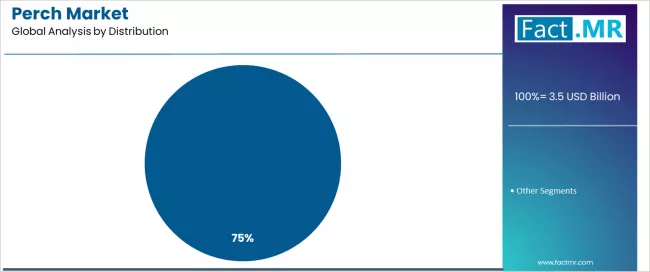
The retail distribution segment is projected to maintain the largest share of perch sales in 2025 with a 57% market share, highlighting its fundamental role in consumer access, direct sales, and seafood market optimization. Consumers prefer retail distribution for their comprehensive shopping benefits, product variety advantages, and proven effectiveness in delivering consistent perch products with reliable availability and consistent quality characteristics. This segment represents the backbone of modern perch distribution across multiple consumer applications and purchasing protocols.
The retail segment benefits from ongoing technological advancement in seafood retail and the expanding adoption of fresh seafood merchandising processes in consumer applications. Retail demand continues to grow due to increasing preference for home cooking, rising consumer awareness of seafood benefits, and the need for distribution methods that can support consumer access while maintaining product quality and freshness standards. As consumer behaviors become more health-focused and cooking requirements increase, the retail distribution segment will continue to drive market growth while supporting advanced perch distribution and consumer access optimization strategies.
What are the Drivers, Restraints, and Key Trends of the Perch Market?
The perch market is advancing steadily due to increasing eco-friendly seafood consumption and environmental awareness driven by climate change concerns and resource conservation priorities, growing adoption of freshwater aquaculture that requires eco-friendly fish species providing enhanced production efficiency and environmental benefits across diverse aquaculture facilities, processing operations, retail markets, and food service establishments. The market faces challenges, including aquaculture production scalability and technical complexities, market awareness limitations in certain regions, and competition from more established fish species and alternative proteins. Innovation in aquaculture technologies and eco-friendly production continues to influence product development and market expansion patterns.
Expansion of Eco-friendly Aquaculture and Environmental Stewardship
The growing development of eco-friendly aquaculture practices is driving demand for environmentally responsible fish species that address eco-compatibility requirements including reduced environmental impact, efficient resource utilization, and comprehensive ecosystem protection support in aquaculture and production settings. Eco-friendly aquaculture applications require advanced perch production that deliver superior environmental benefits across multiple eco-compatibility parameters while maintaining production efficiency and market viability. Aquaculture producers are increasingly recognizing the competitive advantages of eco-friendly species integration for environmental stewardship and market differentiation, creating opportunities for innovative production systems specifically designed for next-generation eco-friendly aquaculture applications.
Integration of Value-Added Processing and Premium Products
Modern seafood processors are incorporating value-added processing systems and premium product technologies to enhance market value, address consumer preferences, and support comprehensive product diversification objectives through optimized processing methods and intelligent product development. Leading companies are developing premium processed products, implementing value-addition enhancement systems, and advancing processing methods that maximize market effectiveness while supporting premium product approaches. These technologies improve product value while enabling new market opportunities, including gourmet applications, premium product systems, and specialty seafood treatments.
Development of Traceability Systems and Quality Assurance
The expansion of traceability technologies, quality assurance systems, and precision monitoring processes is driving demand for perch products with enhanced transparency and specialized quality capabilities. These advanced applications require specialized production platforms with precise quality control and exceptional traceability reliability that exceed traditional seafood requirements, creating premium market segments with differentiated quality propositions. Producers are investing in advanced traceability capabilities and quality system development to serve emerging high-specification applications while supporting innovation in advanced seafood production and quality optimization sectors.
Analysis of the Perch Market by Key Countries
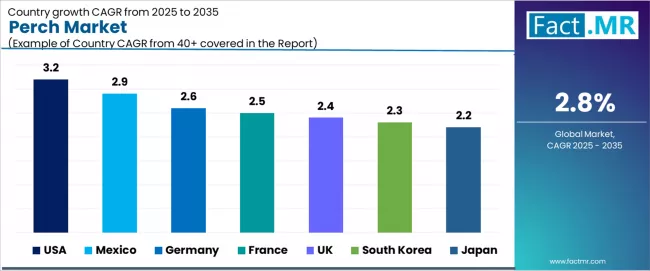
| Country | CAGR (2025-2035) |
|---|---|
| USA | 3.2% |
| Mexico | 2.9% |
| Germany | 2.6% |
| France | 2.5% |
| UK | 2.4% |
| South Korea | 2.3% |
| Japan | 2.2% |
The perch market is experiencing steady growth globally, with the USA leading at a 3.2% CAGR through 2035, driven by expanding eco-friendly seafood demand and growing aquaculture adoption, alongside increasing investment in freshwater fish technologies and eco-friendly production development. Mexico follows at 2.9%, supported by aquaculture expansion programs, growing seafood processing infrastructure, and increasing demand for eco-friendly protein sources in domestic and regional markets. Germany shows growth at 2.6%, emphasizing aquaculture innovation, eco-friendly seafood excellence, and advanced production development. France demonstrates 2.5% growth, supported by seafood advancement and aquaculture technology adoption. The UK records 2.4%, focusing on eco-friendly seafood innovation and aquaculture technology development. South Korea exhibits 2.3% growth, emphasizing aquaculture modernization and eco-friendly seafood applications. Japan shows 2.2% growth, emphasizing quality standards and specialized seafood applications.
USA Leads Global Market Growth with Eco-friendly Seafood Infrastructure and Aquaculture Innovation
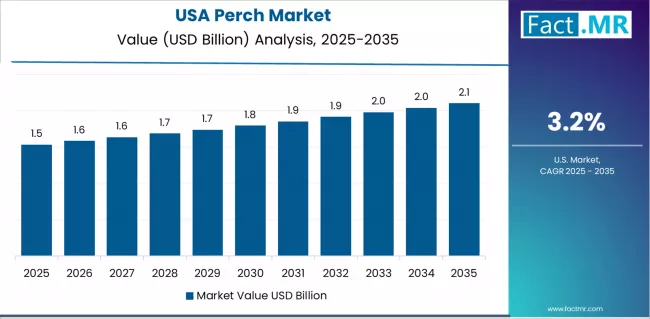
Revenue from perch in the USA is projected to exhibit strong growth with a CAGR of 3.2% through 2035, driven by expanding eco-friendly seafood infrastructure and steadily growing freshwater aquaculture sector supported by environmental consciousness and advanced aquaculture technology adoption. The country's substantial seafood industry and increasing investment in eco-friendly production technologies are creating substantial demand for freshwater fish solutions. Major aquaculture producers and seafood companies are establishing comprehensive perch production capabilities to serve both domestic markets and eco-compatibility requirements.
- Strong eco-friendly seafood expansion and growing environmental awareness requirements are driving demand for perch throughout major aquaculture regions including the Great Lakes region, Pacific Northwest, and aquaculture development corridors, supporting both commercial producers and eco-friendly seafood suppliers.
- Growing health consciousness and eco-friendly protein preference are supporting the steady adoption of perch aquaculture technologies among producers seeking enhanced capabilities and market differentiation in competitive seafood markets.
Mexico Demonstrates Aquaculture Integration with Seafood Infrastructure Development
Demand for perch in Mexico is expanding at a CAGR of 2.9%, supported by aquaculture modernization initiatives, growing seafood processing infrastructure, and strategic position as a eco-friendly protein hub for Latin American markets. Mexico's aquaculture development and seafood technology advancement are driving sophisticated perch production capabilities throughout seafood sectors. Leading aquaculture producers and seafood companies are establishing extensive production facilities to address growing domestic protein and regional market demand.
- Aquaculture modernization and expanding seafood processing infrastructure are creating opportunities for perch production adoption across aquaculture systems, processing facilities, and seafood centers in major coastal regions including Gulf of Mexico and Pacific coast development zones.
- Growing aquaculture sector and seafood technology expansion are supporting the adoption of advanced production technologies among producers seeking to serve both domestic and international markets while maintaining environmental standards and production effectiveness.
Germany Demonstrates Aquaculture Excellence with Eco-friendly Seafood Innovation
Revenue from perch in Germany is growing at a CAGR of 2.6%, driven by the country's aquaculture technology leadership, eco-friendly seafood innovation capabilities, and precision production excellence supporting high-performance perch aquaculture applications. Germany's aquaculture expertise and seafood technology innovation are driving demand for specialized perch production solutions throughout seafood sectors. Leading aquaculture manufacturers and seafood providers are establishing comprehensive innovation programs for next-generation production technologies.
- Advanced aquaculture technology development and eco-friendly seafood innovation requirements are creating demand for specialized perch production among producers and seafood companies seeking enhanced environmental performance and production reliability in competitive European markets.
- Strong aquaculture industry expertise and seafood technology leadership are supporting the adoption of advanced perch production technologies and seafood optimization across production facilities throughout major aquaculture regions including Northern Germany and coastal development areas.
France Shows Seafood Excellence and Aquaculture Innovation Leadership
Demand for perch in France is expected to expand at a CAGR of 2.5%, supported by the country's seafood excellence, aquaculture innovation leadership, and pioneering eco-friendly production advancement initiatives including environmental stewardship procedures and precision aquaculture development. France's seafood heritage and aquaculture expertise are supporting investment in advanced perch production technologies. Major seafood providers and aquaculture technology companies are establishing comprehensive production programs incorporating perch advancement and seafood innovation.
- Advanced seafood innovation and aquaculture technology capabilities are creating demand for premium perch products supporting seafood excellence, aquaculture advancement, and production optimization throughout major seafood and aquaculture technology regions.
- Strong seafood focus and aquaculture technology leadership are driving the adoption of advanced eco-friendly production and seafood enhancement throughout production facilities across seafood excellence clusters and innovation zones.
UK Focuses on Seafood Innovation and Aquaculture Technology Development
Revenue from perch in the UK is growing at a CAGR of 2.4%, driven by the country's seafood innovation, aquaculture technology development initiatives, and emphasis on advanced eco-friendly solutions for seafood and aquaculture applications. The UK's aquaculture research excellence and seafood commitments are supporting investment in advanced perch production technologies. Major seafood providers and aquaculture technology companies are establishing comprehensive production programs incorporating advanced perch production formulations.
- Seafood innovation and aquaculture development requirements are creating demand for high-performance perch products supporting production advancement, seafood innovation, and aquaculture optimization throughout major seafood and aquaculture technology regions.
- Strong research capabilities and seafood mandates are driving the adoption of advanced production technologies and seafood enhancement supporting superior environmental performance and seafood leadership in competitive global markets.
South Korea Demonstrates Seafood Leadership with Aquaculture Technology Focus
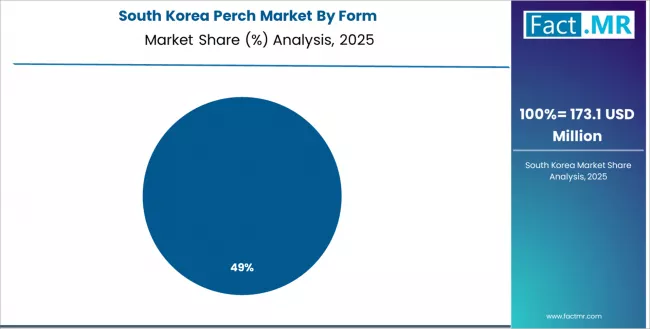
Demand for perch in South Korea is anticipated to expand at a CAGR of 2.3%, supported by the country's seafood modernization, aquaculture technology expertise, and strong emphasis on advanced eco-friendly solutions for comprehensive seafood and aquaculture applications. South Korea's seafood sophistication and aquaculture innovation focus are driving sophisticated perch production capabilities throughout seafood sectors. Leading seafood providers and aquaculture technology companies are investing extensively in advanced production technologies.
- Advanced seafood development and aquaculture technology innovation are creating demand for specialized perch products throughout seafood applications, aquaculture systems, and production facilities in major seafood regions including coastal areas and aquaculture innovation zones.
- Strong seafood industry and aquaculture expertise are supporting the adoption of innovative production technologies and seafood optimization for next-generation applications requiring superior environmental performance and seafood excellence.
Japan Shows Quality Excellence Focus with Specialized Seafood Applications
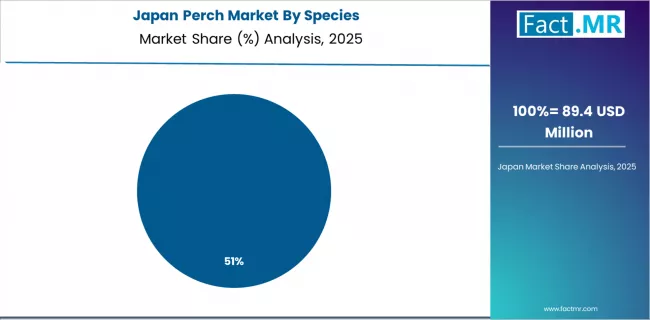
Revenue from perch in Japan is growing at a CAGR of 2.2%, supported by the country's quality excellence standards, specialized seafood capabilities, and strong emphasis on high-specification fish products for advanced seafood and aquaculture sectors. Japan's quality sophistication and seafood excellence are driving demand for premium perch products. Leading seafood providers and aquaculture technology companies are investing in specialized capabilities for advanced seafood applications.
- Advanced seafood processing and quality aquaculture requirements are creating opportunities for high-quality perch products throughout specialized seafood production, aquaculture manufacturing, and fish applications meeting stringent quality and performance standards.
- Strong seafood industry and aquaculture sector are driving adoption of specialized perch production technologies and advanced seafood systems supporting innovation in seafood advancement, aquaculture development, and fish sectors requiring superior taste performance and consistency.
Europe Market Split by Country
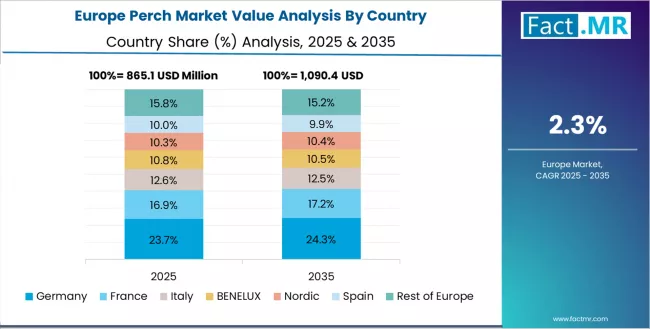
The perch market in Europe is projected to grow from USD 1.0 billion in 2025 to USD 1.3 billion by 2035, registering a CAGR of 2.5% over the forecast period. Germany is expected to maintain its leadership position with a 27.4% market share in 2025, declining slightly to 27.0% by 2035, supported by its advanced aquaculture industry and eco-friendly seafood capabilities.
France follows with a 21.5% share in 2025, projected to reach 21.8% by 2035, driven by comprehensive seafood development and aquaculture technology industry applications. The United Kingdom holds a 19.2% share in 2025, expected to decrease to 18.8% by 2035 due to market diversification. Italy commands a 14.4% share, while Spain accounts for 11.1% in 2025. The Rest of Europe region is anticipated to gain momentum, expanding its collective share from 6.4% to 6.9% by 2035, attributed to increasing eco-friendly seafood adoption in Nordic countries and emerging Eastern European aquaculture markets implementing advanced production technologies.
European Perch Applications Dominate Seafood Services in Japan
The Japanese perch market demonstrates a mature and precision-focused landscape, characterized by advanced integration of European perch production with existing seafood infrastructure across processing facilities, retail networks, and aquaculture operations. Japan's emphasis on quality excellence and seafood precision drives demand for high-reliability perch solutions that support comprehensive seafood initiatives and regulatory requirements in aquaculture operations. The market benefits from strong partnerships between international seafood providers like Regional Aquaculture Companies, Clearwater Seafoods, and domestic seafood leaders, including established aquaculture companies and seafood specialists, creating comprehensive service ecosystems that prioritize product quality and seafood precision programs.
Fresh Applications Lead Seafood Services in South Korea
The South Korean perch market is characterized by strong international seafood application presence, with companies like Marine Harvest, Cermaq, and Tassal maintaining dominant positions through comprehensive system integration and seafood services capabilities for aquaculture modernization and production applications. The market is demonstrating a growing emphasis on localized seafood support and rapid deployment capabilities, as Korean seafood providers increasingly demand customized solutions that integrate with domestic aquaculture infrastructure and advanced seafood systems deployed across major production centers and processing facilities. Local aquaculture companies and regional seafood integrators are gaining market share through strategic partnerships with global providers, offering specialized services including production training programs and certification services for seafood specialists.
Competitive Landscape of the Perch Market
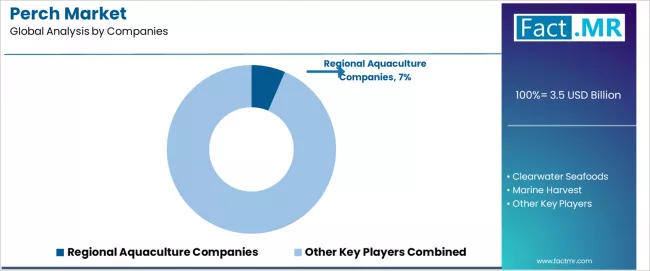
The perch market is characterized by competition among established aquaculture producers, specialized freshwater fish suppliers, and diversified seafood companies. Companies are investing in advanced aquaculture technology development, eco-friendly production innovation, product portfolio expansion, and application-specific production development to deliver high-performance, eco-friendly, and nutritionally effective perch solutions. Innovation in aquaculture technology advancement, eco-friendly production integration, and quality assurance systems is central to strengthening market position and competitive advantage.
Regional aquaculture companies lead the market with a 6.5% share, offering comprehensive perch production solutions with a focus on eco-friendly aquaculture, advanced production technologies, and integrated supply chain platforms across diverse retail and food service distribution channels. The companies have announced major eco-compatibility initiatives and investments in production enhancement to support growing global demand for freshwater fish and eco-friendly protein solutions. Clearwater Seafoods provides innovative seafood solutions with emphasis on quality excellence and eco-friendly technologies, while Marine Harvest delivers specialized aquaculture products with focus on production efficiency and seafood applications. Cermaq offers comprehensive aquaculture solutions with perch offerings for multiple market categories, and Tassal provides advanced aquaculture technologies with emphasis on production systems and seafood optimization. Trident Seafoods specializes in seafood processing solutions with advanced perch technologies, while other key players including Cooke Aquaculture, Bretagne Sea, Aquna, and Grupo Cristal contribute to market competition through specialized aquaculture capabilities and seafood expertise.
Perch Market - Stakeholder Contribution Framework
Perch represents a specialized freshwater fish segment within seafood and aquaculture applications, projected to grow from USD 3.5 billion in 2025 to USD 4.6 billion by 2035 at a 2.8% CAGR. These eco-friendly protein products—primarily European perch, yellow perch, and specialized configurations for multiple applications—serve as critical food sources in retail markets, food service establishments, processing facilities, and export channels where nutritional quality, eco-friendly production, and market availability are essential. Market expansion is driven by increasing eco-friendly seafood demand, growing freshwater aquaculture adoption, expanding protein diversification, and rising demand for advanced eco-friendly solutions across diverse retail, food service, processing, and export sectors.
How Regulatory Bodies Could Strengthen Aquaculture Standards and Food Safety?
- Aquaculture Standards: Establish comprehensive technical specifications for perch production, including quality requirements, eco-compatibility standards, safety validation protocols, and environmental guidelines that ensure consistent performance across aquaculture facilities, processing operations, retail markets, and food service establishments.
- Food Safety Integration: Develop regulatory frameworks that incentivize advanced aquaculture practices, requiring producers to implement quality management systems, utilize safety validation protocols, incorporate food safety procedures, and achieve measurable eco-compatibility improvements in perch production development.
- Quality Assurance Requirements: Implement mandatory quality control standards for perch production, including quality testing protocols, safety verification measures, and eco-compatibility validation systems that ensure product effectiveness and food safety across diverse seafood applications.
- Commercial Grade Guidelines: Create specialized regulations for commercial-grade perch used in food service applications, addressing stringent quality specifications, safety requirements, and regulatory validation specific to seafood applications requiring enhanced reliability and consumer protection.
- Innovation Support Programs: Provide regulatory facilitation and research incentives for development of next-generation aquaculture technologies that improve production outcomes, enhance food safety, and enable emerging applications in eco-friendly production systems and traceability enhancement methods.
How Industry Associations Could Advance Aquaculture Standards and Market Development?
- Seafood Best Practices: Develop comprehensive technical guidelines for perch production selection, aquaculture optimization, and quality validation techniques that maximize production effectiveness, ensure food safety, and maintain cost-effectiveness across aquaculture facilities, processing operations, and seafood applications.
- Food Safety Benchmarking: Establish industry-wide metrics for production performance, including aquaculture efficacy assessment, food safety measurement, eco-compatibility outcome evaluation, and seafood application documentation that enable comparative analysis and drive continuous improvement toward production optimization objectives.
- Professional Training Programs: Create specialized education initiatives for aquaculture professionals, seafood technicians, and production specialists covering perch characteristics, aquaculture applications, quality requirements, and production techniques across diverse seafood applications.
- Seafood Standardization: Develop standardized testing methodologies for perch evaluation, including quality assessment, eco-compatibility analysis, production validation, and application-specific performance metrics that facilitate objective product comparison and seafood validation.
- Aquaculture Collaboration: Facilitate partnerships between perch producers, seafood retailers, research institutions, and aquaculture organizations to advance production development, address emerging seafood challenges, and accelerate innovation in aquaculture applications.
How Perch Producers Could Drive Innovation and Market Leadership?
- Advanced Aquaculture Technologies: Invest in production technology enhancement, eco-compatibility optimization, quality development, and food safety improvement initiatives that enhance production effectiveness while maintaining product reliability and regulatory compliance in global markets.
- Specialized Product Development: Develop specialized perch products with enhanced nutritional characteristics, including optimized protein profiles, improved eco-compatibility properties, increased market versatility, and application-specific performance attributes for emerging seafood segments.
- Quality Control Integration: Implement intelligent quality systems with real-time production monitoring, predictive eco-compatibility assessment, automated quality verification, and data analytics that optimize production performance, ensure seafood reliability, and reduce aquaculture complexity.
- Market Support Services: Establish comprehensive customer service capabilities providing seafood consultation, technical assistance, production troubleshooting, and aquaculture expertise that strengthen customer relationships and enable successful market implementation.
- Global Seafood Excellence: Develop regional service networks, specialized market support management, reliable technical support systems, and responsive customer service that ensure consistent product availability, maintain seafood quality, and support customer market requirements worldwide.
How End-User Industries Could Optimize Nutritional Performance and Market Success?
- Strategic Product Selection: Conduct comprehensive assessments of nutritional requirements, market needs, regulatory constraints, and operational considerations to optimize perch selection and achieve desired nutritional characteristics while managing total protein costs and market outcomes.
- Market Optimization: Implement advanced seafood methodologies utilizing nutritional validation, quality evaluation, and systematic performance assessment to maximize perch nutritional benefits, minimize market complexity, and optimize seafood effectiveness and consumer satisfaction.
- Food Quality Management: Develop optimized market protocols, quality control procedures, and nutritional validation that ensure effective perch utilization, maximize nutritional benefits, and maintain consistent market performance throughout seafood operations.
- Quality Market Integration: Incorporate seafood best practices, food quality principles, and nutritional quality considerations into menu planning and market processes that support comprehensive food objectives and consumer satisfaction excellence.
- Strategic Seafood Partnerships: Establish strategic partnerships with perch producers for joint market programs, nutritional optimization initiatives, and co-innovation projects that address specific food challenges and accelerate seafood commercialization.
How Research Institutions Could Enable Aquaculture Advancement?
- Aquaculture Research Programs: Conduct fundamental investigations into perch production technology, nutritional mechanisms, aquaculture optimization, and seafood applications that advance production understanding and enable breakthrough innovations in aquaculture technology and nutritional science.
- Seafood Development: Develop novel production methods, including advanced aquaculture techniques, eco-compatibility approaches, and nutritional enhancement technologies that improve production performance while maintaining food safety and cost effectiveness.
- Market Application Innovation: Investigate emerging applications for perch in eco-friendly protein, functional foods, premium seafood, and aquaculture innovation that create new market opportunities and expand production potential.
- Nutritional Validation Services: Provide advanced seafood research services utilizing nutritional validation, quality testing, market assessment, and seafood evaluation methodologies that enable detailed understanding of perch properties and market applications.
- Aquaculture Technology Transfer: Facilitate technology commercialization through licensing agreements, startup incubation programs, seafood publications, and collaborative research projects that accelerate aquaculture innovation adoption and strengthen industry-academia partnerships.
How Investors and Financial Enablers Could Support Aquaculture Market Growth?
- Seafood Infrastructure Investment: Provide capital for perch production facility construction, aquaculture capacity expansion, and technology upgrade projects that address growing protein demand while improving operational efficiency and production performance.
- Aquaculture Technology Financing: Fund research and development of breakthrough perch production technologies, including advanced aquaculture methods, eco-compatibility systems, and novel market applications that address current market limitations and create competitive advantages.
- Production Development Support: Finance aquaculture innovation initiatives, production validation programs, regulatory development, and eco-compatibility advancement that enhance production capabilities and position producers for long-term market acceptance and growth.
- Seafood Market Expansion: Support strategic acquisitions, market entry initiatives, distribution network development, and market service capabilities that accelerate geographic expansion and strengthen competitive positions in high-growth seafood markets.
- Global Aquaculture Development: Provide financing and technical assistance for perch production facilities in developing economies, creating new aquaculture supply capabilities, supporting local seafood development, and expanding global market access for eco-friendly protein solutions.
Key Players in the Perch Market
- Regional Aquaculture Companies
- Clearwater Seafoods
- Marine Harvest
- Cermaq
- Tassal
- Trident Seafoods
- Cooke Aquaculture
- Bretagne Sea
- Aquna
- Grupo Cristal
Scope of the Report
| Items | Values |
|---|---|
| Quantitative Units (2025) | USD 3.5 billion |
| Species | European Perch, Yellow Perch, Others |
| Form | Fresh, Frozen, Processed/Fillets |
| Distribution | Retail, Foodservice, Export |
| Regions Covered | North America, Europe, Asia Pacific, Latin America, Middle East & Africa |
| Countries Covered | USA, Germany, France, UK, Japan, South Korea, Mexico, and 40+ countries |
| Key Companies Profiled | Regional Aquaculture Companies, Clearwater Seafoods, Marine Harvest, Cermaq, Tassal, Trident Seafoods |
| Additional Attributes | Dollar sales by species and form category, regional demand trends, competitive landscape, technological advancements in aquaculture production, seafood development, production innovation, and market performance optimization |
Perch Market by Segments
-
Species :
- European Perch
- Yellow Perch
- Others
-
Form :
- Fresh
- Frozen
- Processed/Fillets
-
Distribution :
- Retail
- Foodservice
- Export
-
Region :
-
North America
- United States
- Canada
- Mexico
-
Europe
- Germany
- United Kingdom
- France
- Italy
- Spain
- Netherlands
- Nordic
- BENELUX
- Rest of Europe
-
Asia Pacific
- China
- Japan
- South Korea
- India
- Australia
- Rest of Asia Pacific
-
Latin America
- Brazil
- Argentina
- Chile
- Rest of Latin America
-
Middle East & Africa
- Kingdom of Saudi Arabia
- Other GCC Countries
- Turkey
- South Africa
- Other African Union
- Rest of Middle East & Africa
-
Table of Content
- Executive Summary
- Global Market Outlook
- Demand to side Trends
- Supply to side Trends
- Technology Roadmap Analysis
- Analysis and Recommendations
- Market Overview
- Market Coverage / Taxonomy
- Market Definition / Scope / Limitations
- Market Background
- Market Dynamics
- Drivers
- Restraints
- Opportunity
- Trends
- Scenario Forecast
- Demand in Optimistic Scenario
- Demand in Likely Scenario
- Demand in Conservative Scenario
- Opportunity Map Analysis
- Product Life Cycle Analysis
- Supply Chain Analysis
- Investment Feasibility Matrix
- Value Chain Analysis
- PESTLE and Porter’s Analysis
- Regulatory Landscape
- Regional Parent Market Outlook
- Production and Consumption Statistics
- Import and Export Statistics
- Market Dynamics
- Global Market Analysis 2020 to 2024 and Forecast, 2025 to 2035
- Historical Market Size Value (USD Million) Analysis, 2020 to 2024
- Current and Future Market Size Value (USD Million) Projections, 2025 to 2035
- Y to o to Y Growth Trend Analysis
- Absolute $ Opportunity Analysis
- Global Market Pricing Analysis 2020 to 2024 and Forecast 2025 to 2035
- Global Market Analysis 2020 to 2024 and Forecast 2025 to 2035, By Species
- Introduction / Key Findings
- Historical Market Size Value (USD Million) Analysis By Species , 2020 to 2024
- Current and Future Market Size Value (USD Million) Analysis and Forecast By Species , 2025 to 2035
- European Perch
- Y to o to Y Growth Trend Analysis By Species , 2020 to 2024
- Absolute $ Opportunity Analysis By Species , 2025 to 2035
- Global Market Analysis 2020 to 2024 and Forecast 2025 to 2035, By Form
- Introduction / Key Findings
- Historical Market Size Value (USD Million) Analysis By Form, 2020 to 2024
- Current and Future Market Size Value (USD Million) Analysis and Forecast By Form, 2025 to 2035
- Fresh
- Y to o to Y Growth Trend Analysis By Form, 2020 to 2024
- Absolute $ Opportunity Analysis By Form, 2025 to 2035
- Global Market Analysis 2020 to 2024 and Forecast 2025 to 2035, By Distribution
- Introduction / Key Findings
- Historical Market Size Value (USD Million) Analysis By Distribution, 2020 to 2024
- Current and Future Market Size Value (USD Million) Analysis and Forecast By Distribution, 2025 to 2035
- Retail
- Y to o to Y Growth Trend Analysis By Distribution, 2020 to 2024
- Absolute $ Opportunity Analysis By Distribution, 2025 to 2035
- Global Market Analysis 2020 to 2024 and Forecast 2025 to 2035, By Region
- Introduction
- Historical Market Size Value (USD Million) Analysis By Region, 2020 to 2024
- Current Market Size Value (USD Million) Analysis and Forecast By Region, 2025 to 2035
- North America
- Latin America
- Western Europe
- Eastern Europe
- East Asia
- South Asia and Pacific
- Middle East & Africa
- Market Attractiveness Analysis By Region
- North America Market Analysis 2020 to 2024 and Forecast 2025 to 2035, By Country
- Historical Market Size Value (USD Million) Trend Analysis By Market Taxonomy, 2020 to 2024
- Market Size Value (USD Million) Forecast By Market Taxonomy, 2025 to 2035
- By Country
- USA
- Canada
- Mexico
- By Species
- By Form
- By Distribution
- By Country
- Market Attractiveness Analysis
- By Country
- By Species
- By Form
- By Distribution
- Key Takeaways
- Latin America Market Analysis 2020 to 2024 and Forecast 2025 to 2035, By Country
- Historical Market Size Value (USD Million) Trend Analysis By Market Taxonomy, 2020 to 2024
- Market Size Value (USD Million) Forecast By Market Taxonomy, 2025 to 2035
- By Country
- Brazil
- Chile
- Rest of Latin America
- By Species
- By Form
- By Distribution
- By Country
- Market Attractiveness Analysis
- By Country
- By Species
- By Form
- By Distribution
- Key Takeaways
- Western Europe Market Analysis 2020 to 2024 and Forecast 2025 to 2035, By Country
- Historical Market Size Value (USD Million) Trend Analysis By Market Taxonomy, 2020 to 2024
- Market Size Value (USD Million) Forecast By Market Taxonomy, 2025 to 2035
- By Country
- Germany
- UK
- Italy
- Spain
- France
- Nordic
- BENELUX
- Rest of Western Europe
- By Species
- By Form
- By Distribution
- By Country
- Market Attractiveness Analysis
- By Country
- By Species
- By Form
- By Distribution
- Key Takeaways
- Eastern Europe Market Analysis 2020 to 2024 and Forecast 2025 to 2035, By Country
- Historical Market Size Value (USD Million) Trend Analysis By Market Taxonomy, 2020 to 2024
- Market Size Value (USD Million) Forecast By Market Taxonomy, 2025 to 2035
- By Country
- Russia
- Poland
- Hungary
- Balkan & Baltic
- Rest of Eastern Europe
- By Species
- By Form
- By Distribution
- By Country
- Market Attractiveness Analysis
- By Country
- By Species
- By Form
- By Distribution
- Key Takeaways
- East Asia Market Analysis 2020 to 2024 and Forecast 2025 to 2035, By Country
- Historical Market Size Value (USD Million) Trend Analysis By Market Taxonomy, 2020 to 2024
- Market Size Value (USD Million) Forecast By Market Taxonomy, 2025 to 2035
- By Country
- China
- Japan
- South Korea
- By Species
- By Form
- By Distribution
- By Country
- Market Attractiveness Analysis
- By Country
- By Species
- By Form
- By Distribution
- Key Takeaways
- South Asia and Pacific Market Analysis 2020 to 2024 and Forecast 2025 to 2035, By Country
- Historical Market Size Value (USD Million) Trend Analysis By Market Taxonomy, 2020 to 2024
- Market Size Value (USD Million) Forecast By Market Taxonomy, 2025 to 2035
- By Country
- India
- ASEAN
- Australia & New Zealand
- Rest of South Asia and Pacific
- By Species
- By Form
- By Distribution
- By Country
- Market Attractiveness Analysis
- By Country
- By Species
- By Form
- By Distribution
- Key Takeaways
- Middle East & Africa Market Analysis 2020 to 2024 and Forecast 2025 to 2035, By Country
- Historical Market Size Value (USD Million) Trend Analysis By Market Taxonomy, 2020 to 2024
- Market Size Value (USD Million) Forecast By Market Taxonomy, 2025 to 2035
- By Country
- Kingdom of Saudi Arabia
- Other GCC Countries
- Turkiye
- South Africa
- Other African Union
- Rest of Middle East & Africa
- By Species
- By Form
- By Distribution
- By Country
- Market Attractiveness Analysis
- By Country
- By Species
- By Form
- By Distribution
- Key Takeaways
- Key Countries Market Analysis
- USA
- Pricing Analysis
- Market Share Analysis, 2024
- By Species
- By Form
- By Distribution
- Canada
- Pricing Analysis
- Market Share Analysis, 2024
- By Species
- By Form
- By Distribution
- Mexico
- Pricing Analysis
- Market Share Analysis, 2024
- By Species
- By Form
- By Distribution
- Brazil
- Pricing Analysis
- Market Share Analysis, 2024
- By Species
- By Form
- By Distribution
- Chile
- Pricing Analysis
- Market Share Analysis, 2024
- By Species
- By Form
- By Distribution
- Germany
- Pricing Analysis
- Market Share Analysis, 2024
- By Species
- By Form
- By Distribution
- UK
- Pricing Analysis
- Market Share Analysis, 2024
- By Species
- By Form
- By Distribution
- Italy
- Pricing Analysis
- Market Share Analysis, 2024
- By Species
- By Form
- By Distribution
- Spain
- Pricing Analysis
- Market Share Analysis, 2024
- By Species
- By Form
- By Distribution
- France
- Pricing Analysis
- Market Share Analysis, 2024
- By Species
- By Form
- By Distribution
- India
- Pricing Analysis
- Market Share Analysis, 2024
- By Species
- By Form
- By Distribution
- ASEAN
- Pricing Analysis
- Market Share Analysis, 2024
- By Species
- By Form
- By Distribution
- Australia & New Zealand
- Pricing Analysis
- Market Share Analysis, 2024
- By Species
- By Form
- By Distribution
- China
- Pricing Analysis
- Market Share Analysis, 2024
- By Species
- By Form
- By Distribution
- Japan
- Pricing Analysis
- Market Share Analysis, 2024
- By Species
- By Form
- By Distribution
- South Korea
- Pricing Analysis
- Market Share Analysis, 2024
- By Species
- By Form
- By Distribution
- Russia
- Pricing Analysis
- Market Share Analysis, 2024
- By Species
- By Form
- By Distribution
- Poland
- Pricing Analysis
- Market Share Analysis, 2024
- By Species
- By Form
- By Distribution
- Hungary
- Pricing Analysis
- Market Share Analysis, 2024
- By Species
- By Form
- By Distribution
- Kingdom of Saudi Arabia
- Pricing Analysis
- Market Share Analysis, 2024
- By Species
- By Form
- By Distribution
- Turkiye
- Pricing Analysis
- Market Share Analysis, 2024
- By Species
- By Form
- By Distribution
- South Africa
- Pricing Analysis
- Market Share Analysis, 2024
- By Species
- By Form
- By Distribution
- USA
- Market Structure Analysis
- Competition Dashboard
- Competition Benchmarking
- Market Share Analysis of Top Players
- By Regional
- By Species
- By Form
- By Distribution
- Competition Analysis
- Competition Deep Dive
- Regional Aquaculture Companies
- Overview
- Product Portfolio
- Profitability by Market Segments (Product/Age /Sales Channel/Region)
- Sales Footprint
- Strategy Overview
- Marketing Strategy
- Product Strategy
- Channel Strategy
- Clearwater Seafoods
- Marine Harvest
- Cermaq
- Tassal
- Trident Seafoods
- Cooke Aquaculture
- Bretagne Sea
- Aquna
- Grupo Cristal
- Regional Aquaculture Companies
- Competition Deep Dive
- Assumptions & Acronyms Used
- Research Methodology
List Of Table
- Table 1: Global Market Value (USD Million) Forecast by Region, 2020 to 2035
- Table 2: Global Market Value (USD Million) Forecast by Species , 2020 to 2035
- Table 3: Global Market Value (USD Million) Forecast by Form, 2020 to 2035
- Table 4: Global Market Value (USD Million) Forecast by Distribution, 2020 to 2035
- Table 5: North America Market Value (USD Million) Forecast by Country, 2020 to 2035
- Table 6: North America Market Value (USD Million) Forecast by Species , 2020 to 2035
- Table 7: North America Market Value (USD Million) Forecast by Form, 2020 to 2035
- Table 8: North America Market Value (USD Million) Forecast by Distribution, 2020 to 2035
- Table 9: Latin America Market Value (USD Million) Forecast by Country, 2020 to 2035
- Table 10: Latin America Market Value (USD Million) Forecast by Species , 2020 to 2035
- Table 11: Latin America Market Value (USD Million) Forecast by Form, 2020 to 2035
- Table 12: Latin America Market Value (USD Million) Forecast by Distribution, 2020 to 2035
- Table 13: Western Europe Market Value (USD Million) Forecast by Country, 2020 to 2035
- Table 14: Western Europe Market Value (USD Million) Forecast by Species , 2020 to 2035
- Table 15: Western Europe Market Value (USD Million) Forecast by Form, 2020 to 2035
- Table 16: Western Europe Market Value (USD Million) Forecast by Distribution, 2020 to 2035
- Table 17: Eastern Europe Market Value (USD Million) Forecast by Country, 2020 to 2035
- Table 18: Eastern Europe Market Value (USD Million) Forecast by Species , 2020 to 2035
- Table 19: Eastern Europe Market Value (USD Million) Forecast by Form, 2020 to 2035
- Table 20: Eastern Europe Market Value (USD Million) Forecast by Distribution, 2020 to 2035
- Table 21: East Asia Market Value (USD Million) Forecast by Country, 2020 to 2035
- Table 22: East Asia Market Value (USD Million) Forecast by Species , 2020 to 2035
- Table 23: East Asia Market Value (USD Million) Forecast by Form, 2020 to 2035
- Table 24: East Asia Market Value (USD Million) Forecast by Distribution, 2020 to 2035
- Table 25: South Asia and Pacific Market Value (USD Million) Forecast by Country, 2020 to 2035
- Table 26: South Asia and Pacific Market Value (USD Million) Forecast by Species , 2020 to 2035
- Table 27: South Asia and Pacific Market Value (USD Million) Forecast by Form, 2020 to 2035
- Table 28: South Asia and Pacific Market Value (USD Million) Forecast by Distribution, 2020 to 2035
- Table 29: Middle East & Africa Market Value (USD Million) Forecast by Country, 2020 to 2035
- Table 30: Middle East & Africa Market Value (USD Million) Forecast by Species , 2020 to 2035
- Table 31: Middle East & Africa Market Value (USD Million) Forecast by Form, 2020 to 2035
- Table 32: Middle East & Africa Market Value (USD Million) Forecast by Distribution, 2020 to 2035
List Of Figures
- Figure 1: Global Market Pricing Analysis
- Figure 2: Global Market Value (USD Million) Forecast 2020-2035
- Figure 3: Global Market Value Share and BPS Analysis by Species , 2025 and 2035
- Figure 4: Global Market Y to o to Y Growth Comparison by Species , 2025-2035
- Figure 5: Global Market Attractiveness Analysis by Species
- Figure 6: Global Market Value Share and BPS Analysis by Form, 2025 and 2035
- Figure 7: Global Market Y to o to Y Growth Comparison by Form, 2025-2035
- Figure 8: Global Market Attractiveness Analysis by Form
- Figure 9: Global Market Value Share and BPS Analysis by Distribution, 2025 and 2035
- Figure 10: Global Market Y to o to Y Growth Comparison by Distribution, 2025-2035
- Figure 11: Global Market Attractiveness Analysis by Distribution
- Figure 12: Global Market Value (USD Million) Share and BPS Analysis by Region, 2025 and 2035
- Figure 13: Global Market Y to o to Y Growth Comparison by Region, 2025-2035
- Figure 14: Global Market Attractiveness Analysis by Region
- Figure 15: North America Market Incremental Dollar Opportunity, 2025-2035
- Figure 16: Latin America Market Incremental Dollar Opportunity, 2025-2035
- Figure 17: Western Europe Market Incremental Dollar Opportunity, 2025-2035
- Figure 18: Eastern Europe Market Incremental Dollar Opportunity, 2025-2035
- Figure 19: East Asia Market Incremental Dollar Opportunity, 2025-2035
- Figure 20: South Asia and Pacific Market Incremental Dollar Opportunity, 2025-2035
- Figure 21: Middle East & Africa Market Incremental Dollar Opportunity, 2025-2035
- Figure 22: North America Market Value Share and BPS Analysis by Country, 2025 and 2035
- Figure 23: North America Market Value Share and BPS Analysis by Species , 2025 and 2035
- Figure 24: North America Market Y to o to Y Growth Comparison by Species , 2025-2035
- Figure 25: North America Market Attractiveness Analysis by Species
- Figure 26: North America Market Value Share and BPS Analysis by Form, 2025 and 2035
- Figure 27: North America Market Y to o to Y Growth Comparison by Form, 2025-2035
- Figure 28: North America Market Attractiveness Analysis by Form
- Figure 29: North America Market Value Share and BPS Analysis by Distribution, 2025 and 2035
- Figure 30: North America Market Y to o to Y Growth Comparison by Distribution, 2025-2035
- Figure 31: North America Market Attractiveness Analysis by Distribution
- Figure 32: Latin America Market Value Share and BPS Analysis by Country, 2025 and 2035
- Figure 33: Latin America Market Value Share and BPS Analysis by Species , 2025 and 2035
- Figure 34: Latin America Market Y to o to Y Growth Comparison by Species , 2025-2035
- Figure 35: Latin America Market Attractiveness Analysis by Species
- Figure 36: Latin America Market Value Share and BPS Analysis by Form, 2025 and 2035
- Figure 37: Latin America Market Y to o to Y Growth Comparison by Form, 2025-2035
- Figure 38: Latin America Market Attractiveness Analysis by Form
- Figure 39: Latin America Market Value Share and BPS Analysis by Distribution, 2025 and 2035
- Figure 40: Latin America Market Y to o to Y Growth Comparison by Distribution, 2025-2035
- Figure 41: Latin America Market Attractiveness Analysis by Distribution
- Figure 42: Western Europe Market Value Share and BPS Analysis by Country, 2025 and 2035
- Figure 43: Western Europe Market Value Share and BPS Analysis by Species , 2025 and 2035
- Figure 44: Western Europe Market Y to o to Y Growth Comparison by Species , 2025-2035
- Figure 45: Western Europe Market Attractiveness Analysis by Species
- Figure 46: Western Europe Market Value Share and BPS Analysis by Form, 2025 and 2035
- Figure 47: Western Europe Market Y to o to Y Growth Comparison by Form, 2025-2035
- Figure 48: Western Europe Market Attractiveness Analysis by Form
- Figure 49: Western Europe Market Value Share and BPS Analysis by Distribution, 2025 and 2035
- Figure 50: Western Europe Market Y to o to Y Growth Comparison by Distribution, 2025-2035
- Figure 51: Western Europe Market Attractiveness Analysis by Distribution
- Figure 52: Eastern Europe Market Value Share and BPS Analysis by Country, 2025 and 2035
- Figure 53: Eastern Europe Market Value Share and BPS Analysis by Species , 2025 and 2035
- Figure 54: Eastern Europe Market Y to o to Y Growth Comparison by Species , 2025-2035
- Figure 55: Eastern Europe Market Attractiveness Analysis by Species
- Figure 56: Eastern Europe Market Value Share and BPS Analysis by Form, 2025 and 2035
- Figure 57: Eastern Europe Market Y to o to Y Growth Comparison by Form, 2025-2035
- Figure 58: Eastern Europe Market Attractiveness Analysis by Form
- Figure 59: Eastern Europe Market Value Share and BPS Analysis by Distribution, 2025 and 2035
- Figure 60: Eastern Europe Market Y to o to Y Growth Comparison by Distribution, 2025-2035
- Figure 61: Eastern Europe Market Attractiveness Analysis by Distribution
- Figure 62: East Asia Market Value Share and BPS Analysis by Country, 2025 and 2035
- Figure 63: East Asia Market Value Share and BPS Analysis by Species , 2025 and 2035
- Figure 64: East Asia Market Y to o to Y Growth Comparison by Species , 2025-2035
- Figure 65: East Asia Market Attractiveness Analysis by Species
- Figure 66: East Asia Market Value Share and BPS Analysis by Form, 2025 and 2035
- Figure 67: East Asia Market Y to o to Y Growth Comparison by Form, 2025-2035
- Figure 68: East Asia Market Attractiveness Analysis by Form
- Figure 69: East Asia Market Value Share and BPS Analysis by Distribution, 2025 and 2035
- Figure 70: East Asia Market Y to o to Y Growth Comparison by Distribution, 2025-2035
- Figure 71: East Asia Market Attractiveness Analysis by Distribution
- Figure 72: South Asia and Pacific Market Value Share and BPS Analysis by Country, 2025 and 2035
- Figure 73: South Asia and Pacific Market Value Share and BPS Analysis by Species , 2025 and 2035
- Figure 74: South Asia and Pacific Market Y to o to Y Growth Comparison by Species , 2025-2035
- Figure 75: South Asia and Pacific Market Attractiveness Analysis by Species
- Figure 76: South Asia and Pacific Market Value Share and BPS Analysis by Form, 2025 and 2035
- Figure 77: South Asia and Pacific Market Y to o to Y Growth Comparison by Form, 2025-2035
- Figure 78: South Asia and Pacific Market Attractiveness Analysis by Form
- Figure 79: South Asia and Pacific Market Value Share and BPS Analysis by Distribution, 2025 and 2035
- Figure 80: South Asia and Pacific Market Y to o to Y Growth Comparison by Distribution, 2025-2035
- Figure 81: South Asia and Pacific Market Attractiveness Analysis by Distribution
- Figure 82: Middle East & Africa Market Value Share and BPS Analysis by Country, 2025 and 2035
- Figure 83: Middle East & Africa Market Value Share and BPS Analysis by Species , 2025 and 2035
- Figure 84: Middle East & Africa Market Y to o to Y Growth Comparison by Species , 2025-2035
- Figure 85: Middle East & Africa Market Attractiveness Analysis by Species
- Figure 86: Middle East & Africa Market Value Share and BPS Analysis by Form, 2025 and 2035
- Figure 87: Middle East & Africa Market Y to o to Y Growth Comparison by Form, 2025-2035
- Figure 88: Middle East & Africa Market Attractiveness Analysis by Form
- Figure 89: Middle East & Africa Market Value Share and BPS Analysis by Distribution, 2025 and 2035
- Figure 90: Middle East & Africa Market Y to o to Y Growth Comparison by Distribution, 2025-2035
- Figure 91: Middle East & Africa Market Attractiveness Analysis by Distribution
- Figure 92: Global Market - Tier Structure Analysis
- Figure 93: Global Market - Company Share Analysis
- FAQs -
How big is the perch market in 2025?
The global perch market is estimated to be valued at USD 3.5 billion in 2025.
What will be the size of perch market in 2035?
The market size for the perch market is projected to reach USD 4.6 billion by 2035.
How much will be the perch market growth between 2025 and 2035?
The perch market is expected to grow at a 2.8% CAGR between 2025 and 2035.
What are the key product types in the perch market?
The key product types in perch market are european perch .
Which form segment to contribute significant share in the perch market in 2025?
In terms of form, fresh segment to command 48.0% share in the perch market in 2025.